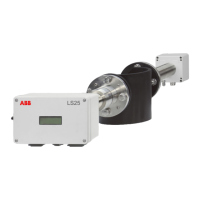76 AO2000-LS25 LASER ANALYZERS | OI/AO2000-LS25-EN REV. D
… 13 Maintenance
… Optimizing purging gas flow of the
flanges
4. From the data in the log file calculate the ratio of
measured gas concentration without and with flange
purge gas.
– Compare the result with the ratio of the length RU-to-
TU-window to the length flange-tip-to-flange-tip.
From this one can estimate the “fill-fraction” of purge
gas in the flanges.
– If the ratios are equal the flanges are completely filled
with purge gas.
– If the gas-ratio is less than the length-ratio the
flanges are only partly filled with purge gas.
5. Adjust the amount of purge gas and repeat the test until
the flanges are filled with purge gas.
Alternative 2:
1. Set the measuring length of the device so that the window
distance between RU and TU is the same, see Optical path
through gas (m) on page 59.
2. Turn off the purge gas flow for sufficiently long until the
flanges are filled with gas from the sample gas path and the
concentration can be measured.
3. Reset the measurement length equal to the distance from
flange tip to flange tip.
4. Increase the purge gas flow until it measures the same as in
step 2.
If the windows have become dirty during the tests, remember to
clean them. If the required amount of purge gas is difficult to
obtain, alternatively the parameter “Optical path through gas”
can subsequently be adjusted on the basis of the test results,
see Optical path through gas (m) on page 59.
Calibration of the device
Note
The analyzer is calibrated ex works with a certified gas mixture.
A calibration certificate is supplied with the device. There is
therefore no need for the user to calibrate the instrument upon
reception.
After some period of operation the device parameters may
change due to aging of the diode laser. In this case a new
calibration might be necessary.
ABB recommends verifying calibration of the device once a year
using a certified sample gas and the supplied calibration cell.
The certified sample gas should in most cases be a mixture of
nitrogen with the measured gas.
The O
2
analyzer can be tested and calibrated using dried air.
Percent level H
2
O analyzers are normally calibrated using
calibration gas generators (e.g. type HovaCAL) to generate
defined moisture concentrations. If any other method is desired,
please contact ABB Service.
Since the calibration of the instrument affects all subsequent
measurements, the user should verify the need for a new
calibration.
We do not recommend performing a calibration if the device
readings deviate less than 2 to 3 % from the nominal value within
the recommended concentration levels indicated below.
This is the typical absolute accuracy for calibration gas mixtures.
The precision of the analyzer should also be taken into account:
this is about 1 % of the measured value if pressure and
temperature are correctly set in the device.
The second harmonic technique used in the analyzer is
intrinsically a baseline-free technique. Therefore, a calibration of
the zero level is never done.
If an attempt is made to calibrate the zero level, the service
program will display an error message. The monitor can only be
calibrated if it detects an absorption signal amplitude above a
predefined level.
This level is factory set and is typically 20 times the detection
limit for an optical path length of 1 m.

